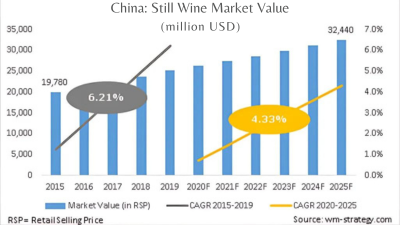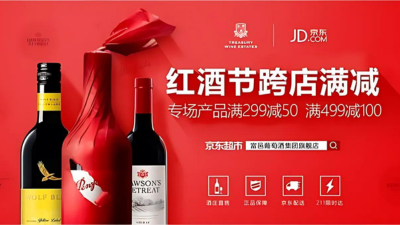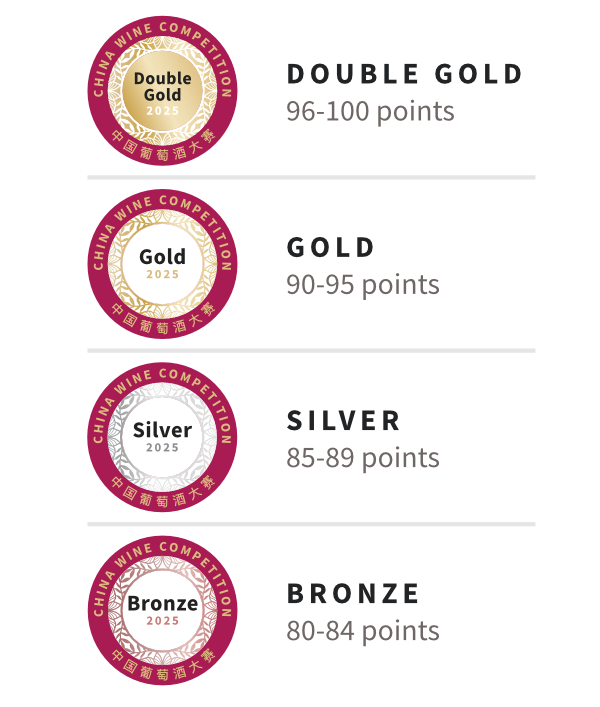November 10 , 2026, Hong Kong

Insights
China's Wine Demand: Trends And Opportunities For International Wineries In 2025
Exploring China's evolving wine market, key trends, and what international wineries should expect to succeed in this dynamic landscape.
China's wine market has witnessed significant growth over the past two decades, evolving from a niche segment to one of the most dynamic wine markets globally. With an expanding middle class, changing consumer preferences, and a growing appreciation for fine wines, China has become a key market for international wineries. As we approach a new year, understanding the trends and demand in the Chinese wine market is crucial for international wineries aiming to tap into this lucrative opportunity. This article delves into the current state of China's wine market, emerging trends, and what international wineries can expect in 2025.
China's Wine Market
Historical Growth and Current Landscape:
China's wine market has grown rapidly since the early 2000s, fueled by the country's economic expansion and increasing disposable incomes. The market was traditionally dominated by local rice wines and spirits like baijiu, but Western-style wines have gained popularity, particularly among younger consumers and the urban middle class. By 2020, China had become the world's fifth-largest wine-consuming country, with a market value exceeding $14 billion.
However, the market is not without its challenges. In recent years, growth has slowed due to economic headwinds, changing government policies, and the impact of the COVID-19 pandemic. Despite these setbacks, according to International Wine and Spirit Research (IWSR), the long-term prospects remain promising, with a projected market value of $23 billion by 2025. This growth will be driven by increasing consumer sophistication, a preference for premium wines, and the continued expansion of the middle class.

Source: Williams & Marshall Strategy
Demographic and Consumer Insights:
The Chinese wine consumer base is diverse, but certain demographic trends are noteworthy. The younger generation, especially those in their 20s and 30s, are driving the demand for wine. These consumers are more open to experimenting with new flavors and are influenced by Western lifestyles, which have been popularized through media and travel. They are also more likely to choose wine over traditional Chinese spirits due to its perceived health benefits and lower alcohol content.
Another key demographic is the affluent middle and upper-middle class, with a growing appetite for premium and luxury wines. These consumers often associate wine with social status and are willing to pay a premium for high-quality, imported wines. As income levels continue to rise, the demand for such wines is expected to grow, making China an attractive market for international wineries targeting the premium segment.
Emerging Trends in China's Wine Market
1) Shift Towards Premiumization: One of the most significant trends in China's wine market is the shift towards premiumization. As Chinese consumers become more discerning, there is a growing demand for high-quality wines. This trend is particularly pronounced among younger consumers who are willing to spend more on wines that offer a unique experience, whether in terms of flavor, origin, or brand prestige. This shift has led to an increase in the consumption of premium wines from established wine-producing regions such as Bordeaux, Burgundy, and Napa Valley. In response, international wineries are focusing on marketing their high-end products, emphasizing their heritage, craftsmanship, and exclusivity.
2) Rise of E-commerce and Digital Marketing: E-commerce has revolutionized the way wine is sold in China. The convenience of online shopping, coupled with the widespread use of smartphones and digital payment systems, has made e-commerce platforms a popular channel for wine purchases. Leading platforms like Tmall, JD.com, and Pinduoduo have become important players in the wine retail landscape, offering a wide range of products from domestic and international brands. Digital marketing, particularly through social media and influencers, has also become a crucial tool for reaching Chinese consumers. Platforms like WeChat, Weibo, and Douyin (TikTok) allow wineries to engage directly with consumers, build brand awareness, and drive sales. In the coming years, the importance of e-commerce and digital marketing in the wine industry will only grow, and wineries that can effectively leverage these channels will have a competitive edge.

Source: JD Corporate Blog
3) Health Consciousness: Health consciousness is on the rise in China, and this is influencing consumer choices in the wine market. There is a growing awareness of the health benefits associated with moderate wine consumption, particularly red wine, which is perceived to have cardiovascular benefits. This has led to an increase in demand for wines that are marketed as natural, organic, or low in sulfites. International wineries that offer organic or biodynamic wines are well-positioned to capitalize on this trend. By 2025, the market for organic wines in China is expected to grow significantly, driven by consumers who prioritize health and sustainability in their purchasing decisions. Wineries that can offer transparency in their production processes and certifications will find a receptive audience in China.
4) Diversification of Wine Preferences: While red wine has traditionally dominated the Chinese market, there is a growing interest in other wine varieties, including white, rosé, and sparkling wine. This diversification is partly driven by younger consumers who are more willing to experiment with different wine styles. Additionally, the growing popularity of Western cuisine in China has increased the demand for wines that pair well with these foods, such as white wines and rosés. International wineries can tap into this trend by expanding their portfolios to include a wider range of wine styles.
5) The Influence of Wine Education: As Chinese consumers become more sophisticated, there is a growing interest in wine education. Wine appreciation courses, tastings, and certifications have become increasingly popular, particularly in major cities like Shanghai, Beijing, and Guangzhou. Consumers are eager to learn about different wine varieties, regions, and food pairings, which enhances their overall wine experience. This trend presents an opportunity for international wineries to engage with consumers through educational initiatives. By offering wine education programs, wineries can build brand loyalty and position themselves as experts in the field.

Source: WSET Global
Challenges and Opportunities for International Wineries
1) Navigating Regulatory Hurdles: One of the key challenges for international wineries looking to enter or expand in the Chinese market is navigating the complex regulatory environment. China has stringent import regulations, including tariffs, labeling requirements, and health and safety standards. These regulations can vary by region, adding to the complexity. However, despite these challenges, the Chinese government has shown a willingness to support the growth of the wine industry, particularly as it aligns with broader goals of increasing domestic consumption and promoting cultural exchange.
2) Building Brand Awareness and Loyalty: Building brand awareness in China requires a deep understanding of local consumer behavior and preferences. Unlike Western markets, where brand loyalty can be built over generations, the Chinese wine market is still relatively young, and consumers are often influenced by trends and recommendations from peers or influencers. To succeed, international wineries need to invest in targeted marketing campaigns that resonate with Chinese consumers. This includes leveraging local celebrities or influencers, participating in wine exhibitions and events, and engaging with consumers through social media.

Source: Vino Joy News
3) Strategic Partnerships and Distribution Channels: Distribution remains one of the most significant challenges for international wineries in China. The country's vast size and diverse regional markets make it difficult to establish a consistent distribution network. Partnering with local distributors who have a deep understanding of the market is often necessary to ensure efficient and widespread distribution. In addition to traditional distribution channels, wineries should explore partnerships with e-commerce platforms, which have become a major sales channel for wine in China.
4) The Impact of Domestic Wine Production: China's domestic wine industry has grown significantly in recent years, with regions like Ningxia, Shandong, and Xinjiang emerging as important wine-producing areas. While domestic wines currently occupy a smaller market share compared to imported wines, their quality has improved, and they are increasingly gaining recognition both domestically and internationally. International wineries need to be aware of the growing competition from domestic producers. However, this also presents an opportunity for collaboration. Joint ventures, partnerships, or sourcing local grapes for specific product lines could help international wineries tap into the domestic market while also mitigating some of the challenges associated with imports.

Source: Jeannie Cho Lee
What to Expect in 2025?
As we approach 2025, the Chinese wine market is poised for continued growth, driven by the factors discussed above. International wineries can expect a more sophisticated and discerning consumer base, with a strong preference for premium and diverse wine offerings. The rise of e-commerce, coupled with the growing importance of digital marketing and wine education, will shape the way wines are sold and consumed in China. To succeed in this evolving market, international wineries must be adaptable, innovative, and culturally aware. By understanding and responding to the unique dynamics of the Chinese wine market, wineries can position themselves for long-term success in one of the world's most exciting markets.
The Chinese wine market will be characterized by increased consumer sophistication, a demand for premium and diverse wines, and a strong emphasis on e-commerce and digital engagement. For international wineries, the opportunities are vast, but success will require a strategic approach that includes navigating regulatory challenges, building brand awareness, and leveraging local partnerships. By understanding the trends and preparing for the future, international wineries can tap into the immense potential of China's wine market and establish a lasting presence in this dynamic landscape.
Check Relevant Articles:
China’s Leading Wine Importers - A Comprehensive Guide For International Brands
Top Wine People Of China To Watch Out For
Header Image Source: Cellar Asia
The 2025 China Competitions results are now live. View 2025 winners.
Key Dates
Super Early Bird Deadline: May 20, 2026
Early Bird Deadline: July 31, 2026
Regular Deadline: October 14, 2026
Warehouse Deadline: October 22, 2026
Judging Date: November 10, 2026
Winners Announcement: November 24, 2026



